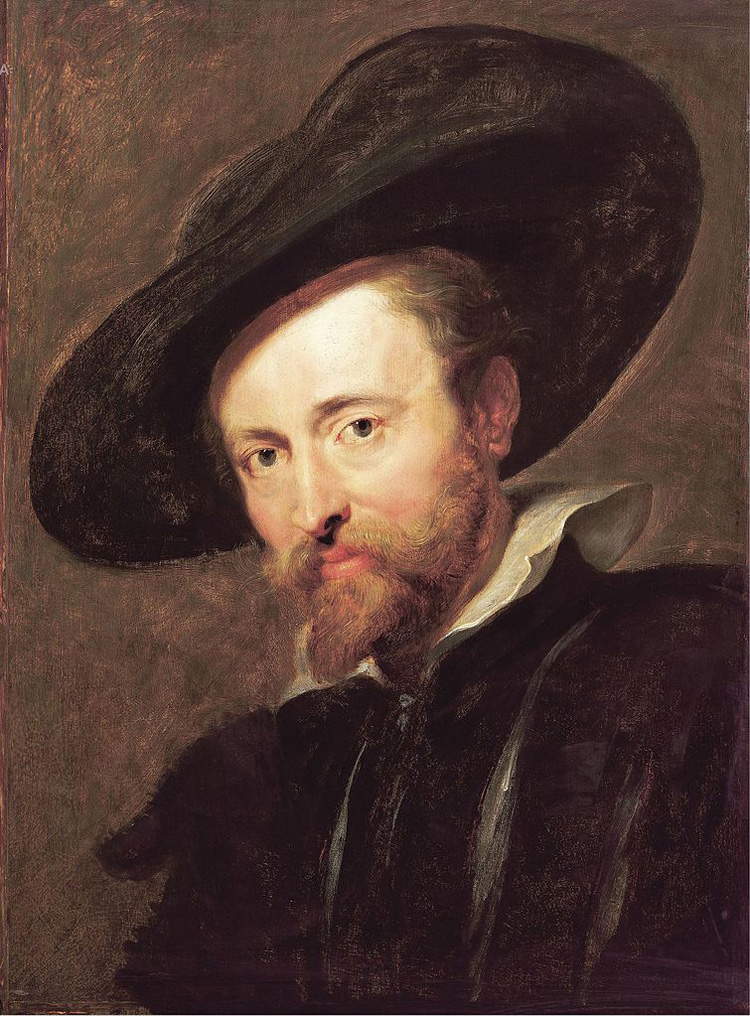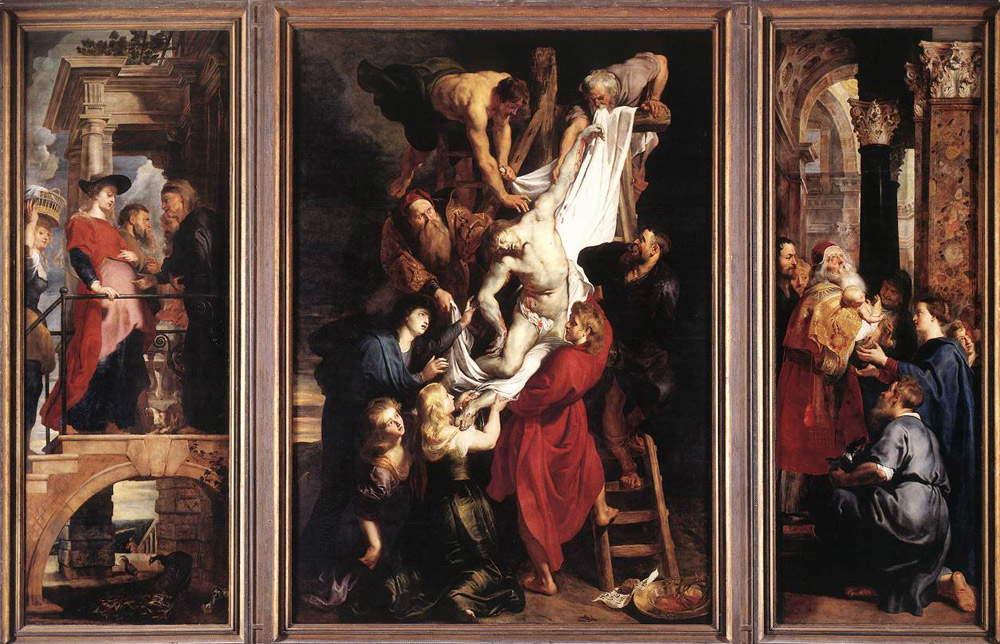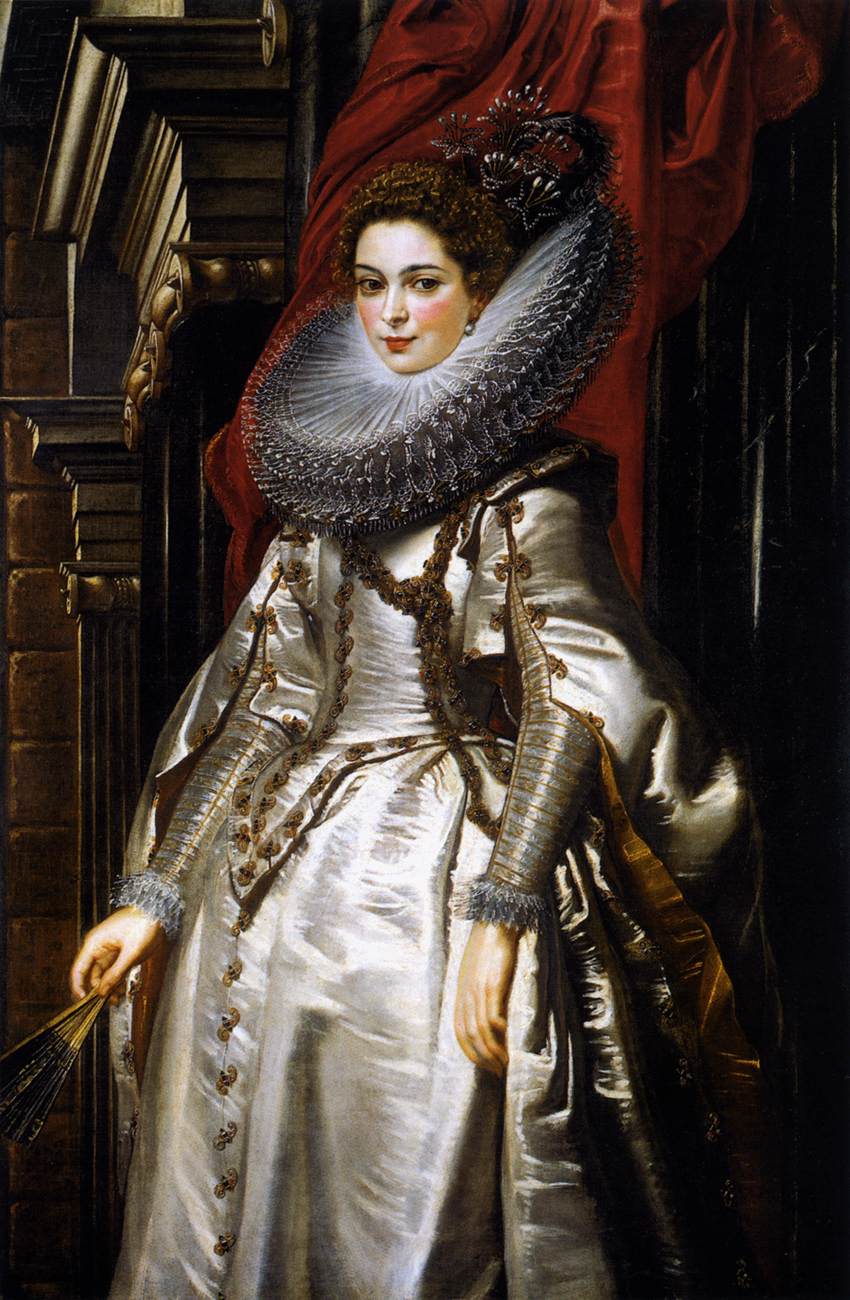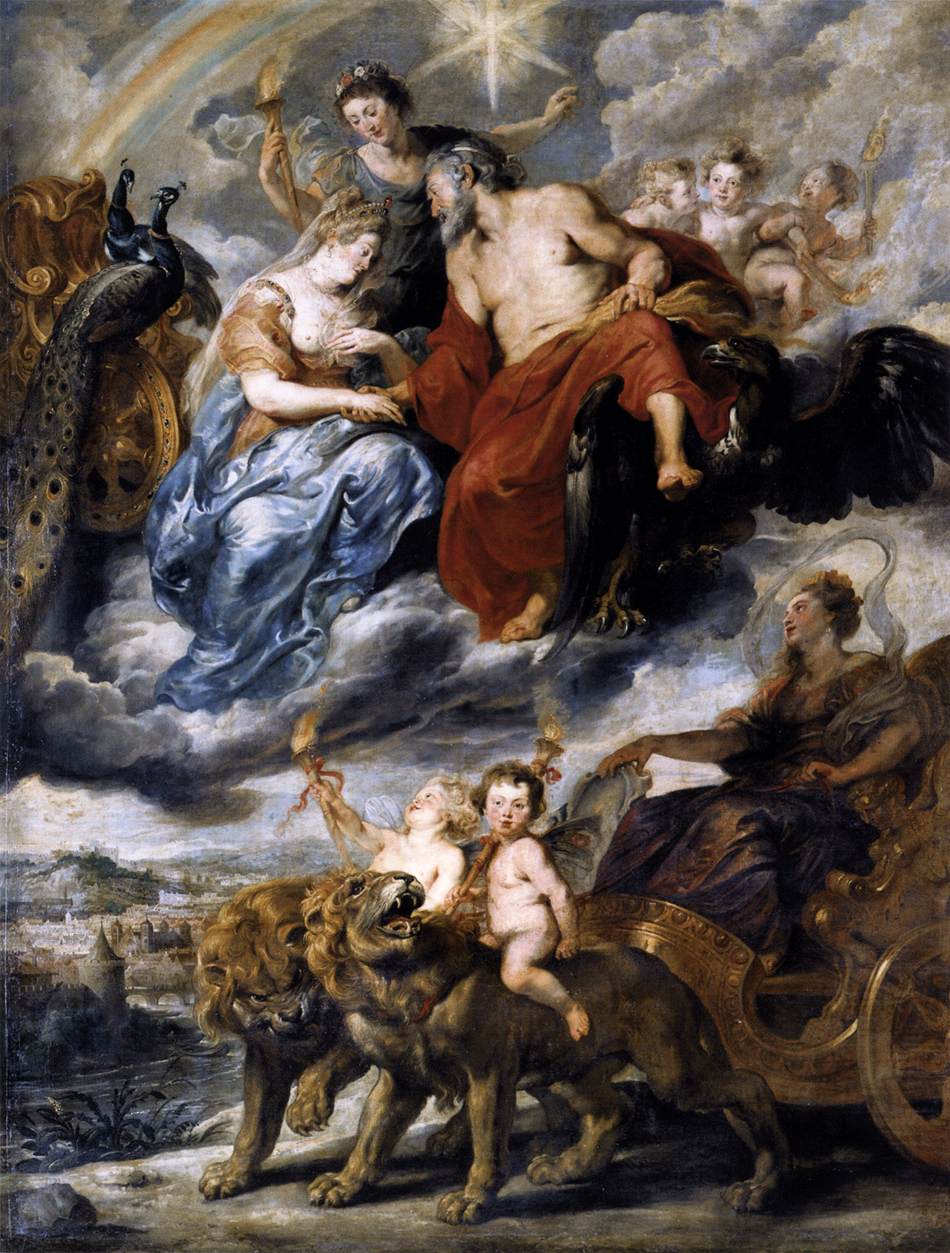Pieter Paul Rubens (Siegen, 1577 - Antwerp, 1640) was a Flemish painter, forerunner of some characteristic features ofBaroque art. Rubens’s life and pictorial production are closely linked to the European courts, which called on him to produce numerous works; also profound was his connection with Italian art, which he studied in depth and brought fully into his works.
An educated, open-minded artist(read more about his personality here), he studied in Italy where he had the opportunity to study many of his models in depth (from Raphael to Michelangelo, from Venetian painters to Caravaggio) and where he worked for important patrons. His highly innovative way of conceiving space, his full color, his blazing use of light, and his exuberant compositions anticipated many of the elements of Baroque culture, of which he is considered one of the great pioneers. His art was then known for the sensuality emanating from his bodies and the fullness of his figures, among the most recognizable in the history of art.

Pieter Paul Rubens painter was born on June 28, 1577 in Germany, in the Westphalian city of Siegen, and spent his childhood in Cologne. Rubens’ family, Flemish, was forced to take refuge there to escape some persecution by the Spanish against Protestants, his father being of the Calvinist faith. In 1589 she moved to Antwerp, where she completed her classical studies, studying Latin and literature. During this period, he also converted to Catholicism. At about the age of sixteen, in 1591, the artist began his artistic training at the workshop of Tobias Verhaecht, a Flemish master specializing in landscape paintings in the wake of Pieter Bruegel the Elder. He began to try his hand at works with epic and religious themes, and also collaborated four-handedly with other painters on landscape canvases with human figures, as was the rule in Antwerp workshops.
In 1598 he joined the Antwerp Guild of St. Luke as a master. The Guild of St. Luke (named after the patron saint of artists) was a union of artists, craftsmen, merchants and art lovers found in several Flemish cities, including Antwerp, which over the years had various powers granted by local governments. The guild, for example, could regulate trade in the arts. For artists, belonging to a Guild gave access to various privileges, such as hiring apprentices in their workshops. Moved by the intent to further his artistic knowledge, Rubens left forItaly in 1600. He initially settled in Venice, where he was able to study the masterpieces of Titian, Tintoretto and Veronese. He later moved to Mantua, where he came into contact with Duke Vincenzo I Gonzaga, who wanted him with him as court painter. Rubens stayed at the Gonzaga court for eight years, or almost his entire stay in Italy, and had access to the duke’s vast private collection, studying Italian art even more thoroughly.
In 1601, the duke sent Rubens to Rome with the task of replicating some paintings, and it was an opportunity for the artist to come into contact with Cardinal Scipione Borghese. Rubens was thus able to closely admire and study Michelangelo Buonarroti, Raphael Sanzio and ancient art. During his stay he also produced some works for the chapel of St. Helen in the basilica of Santa Croce in Gerusalemme, and other paintings such as The Lamentation over the Dead Christ and The Martyrdom of St. Sebastian, which are still preserved in Rome today. He later left Rome to go, again on behalf of the Duke of Mantua, first to Spain, and then to Genoa, where he executed a number of works that were important for the development of the local Baroque(read more about Rubens’ works in Genoa here). He returned to Rome again and was commissioned to decorate the apse of the church of Santa Maria in Vallicella, a work on which he intervened twice, completely replacing what had already been done with new paintings made on a slate base, when it became clear that the initial work would not be clearly visible in the light of the church itself. Once he returned permanently to Antwerp in 1609, Rubens obtained the protection of the governor of the southern Low Countries, Archduke Albert of Habsburg.
An intense and flourishing period of commissions followed soon after, so much so that Rubens, in order to fulfill all the requests, decided to open a workshop to take advantage of the help of collaborators who were wisely chosen on the basis of their specializations. Rubens, therefore, had an almost industrial approach to his workshop, to whom he left the material realization of his cues that he put down on preparatory cartoons. In time, then, he abandoned this sharp division between idea and realization. Among the commissions entrusted to Rubens was that of Marie de’ Medici, the mother of the French king Louis XIII, who rather unusually for the time asked the Flemish artist to paint some episodes that had taken place a few years earlier, namely a cycle of paintings recounting the attempts of Marie dè Medici to secure peace between France and the Habsburg empire through the public declaration of the secret 1610 Treaty of Burzolo against Spain and the union of her own children in marriage with Spanish royalty.
Around 1624, Rubens began a collaboration with the artist Paulus Pontius and continued until the last years of his life to create works on royal commission. He painted several works for Isabella of Habsburg, a few years later instead we find him working for Charles I of England, later he worked for Philip IV of Spain and Ferdinand of Austria. He spent the last years of his life working at a fast pace for the greats of Europe and passed away in Antwerp on May 30, 1640.





Rubens’ works are characterized by a mixture of Classical and Baroque elements. Both a great, typically Baroque pomp and circumstance and elements inferred from ancient statues are recognizable. Reviewing his painting production, it is possible to see how the works of his youth fall within the Flemish tradition of landscape paintings, made in collaboration with other artists and in which he was responsible for inserting human figures. During his Italian sojourn and particularly during his years in Rome, Rubens produced commissioned works and altarpieces with religious themes. Of particular note is the Deposition in the Tomb, in which it is possible to see inspiration from Titian’s painting of the same name, which Rubens had seen in Spain on a mission for Vincenzo Gonzaga and reported as a sketch on his notes. Numerous cues can also be traced from the Italian works of art he studied during his stay.
The Circumcision, painted in 1605 in Genoa, is prodromal of the Baroque in the very bold foreshortening of the representation, in which we see angels descending from above on the small crowd following the act of Jesus’ circumcision, giving the composition a very impetuous feeling certainly accentuated by the dark tones of the background and the exaltation of the divine light coming from above. Even in the non-religious paintings, such as the Portrait of Brigida Spinola Doria (1606), also painted in Genoa, the combination of dark and lighter tones is very decisive. During his second stay in Rome, as we have seen, Rubens produced works for the apse of the church of Santa Maria in Vallicella or Chiesa Nuova, including the famous Madonna della Vallicella, a peculiar work in that it is a fresco icon inserted into a slate altarpiece. The further peculiarity of this altarpiece is that the icon representing the Virgin and Blessing Child is protected by a copper plate that reproduces exactly the same image. The plate, moreover, can be lifted up. Enveloping around it are figures of adoring angels and cherubs who seem to descend from the clouds bearing and supporting the icon itself. Below them, a small crowd gazes upward at the scene. Some details such as the hands of the onlookers and the feet of the cherubs come out outside the canvas suggesting that the scene continues to expand infinitely outside the frame, and this framing would be taken up in full by Baroque painting. On either side of the Madonna are found forming a triptych two other slate altarpieces depicting the saints whose relics are preserved inside the church, namely St. Gregory the Great, St. Papias and St. Maurus on the left while Sts. Flavia, Domitilla, Nereus and Achilleus on the right. The side altarpieces are arranged in such a way that the saints appear to be gazing at the icon of the virgin, tracing an example Rubens had seen in the Roman church of San Gregorio al Celio by Carracci. These works are the only ones by Rubens that are still in their original location.
After his Italian sojourn, Rubens returned to Antwerp, and the works dated between 1609 and 1611 are fully influenced by the masterpieces he had admired in Rome, see especially Samson and Delilah (1609) in which echoes of Caravaggio are evident in the theatricality given to the scene and in the stark contrast between light and shadow, while the muscular and powerful figures are certainly derived from Michelangelo’s frescoes. In any case, a turning point in Rubens’s style took place in 1612, probably due to the Counter-Reformation, as works with lighter colors and composed of figures arranged in a more balanced way in space, rendered with plastic poses echoing Greek statues (surely a legacy of the artist’s Italian period), are noticeable from this period. In fact, the debate around sacred images introduced by Protestantism at the end of the 16th century had led to the decree De invocatione, veneratione et reliquis sanctorum et sacris imaginibus, through which the Church of Rome regulated the local clergy’s control over works of art, which had to meet precise requirements: they had to be clear, well-readable and adherent to sacred scripture. The climate created as a result of these innovations resulted, in most cases, in an autonomous stylistic change on the part of the artists, without the need for outside intervention. The work by Rubens that most expresses this change is the Triptych of the Deposition from the Cross (1611-1614), in which although we find a very theatrical and dramatic setting of the scene portrayed, entrusted to the faces tried by the emotions and the certainly not natural poses of the characters, the colors are mostly muted. The fulcrum of the composition is the holy shroud, which seems to emanate a light of its own, going to brighten the whole painting and especially the red color of the robe worn by the young apostle John, mitigated more toward orange than deep red. The body of Christ, depicted in a contorted position, would seem to be a quotation from the Laocoon statue, preserved at the Vatican museums in Rome.
Rubens was involved in a series of very demanding commissions in the late 1910s and early 1920s, being cycles of paintings. In fact, he made seven tapestries depicting the Stories of Decius Mure (1617-1618), the first instance in which Rubens embarked on a project of such magnitude, in which a series of allegorical and celebratory images told the story of the Roman consul who went to fight in the battle of Vesuvius, aware that he was going to make a sacrifice in his own right and rising to the status of a symbol of patriotism. In this series of tapestries, Rubens uses the historical setting to take up and quote numerous works of antiquity, in particular it is possible to recognize portions of Trajan’s column, elements from Raphael’s frescoes, and images of verisimilitude animals taken from paintings by various authors. The scene of the Death of Decius Mure, on the other hand, pays homage to the Battle of Anghiari, the famous unfinished fresco by Leonardo da Vinci known from copies, particularly the equestrian battle scene in the center of the work that Rubens knew well, as he had traced it in a drawing now in the Louvre in Paris.
The Cycle of Maria de’ Medici, Rubens’ second major pictorial project, consisted of no fewer than twenty-four canvases. The rather recent episodes, that is, a series of events related to the personal and political life of the woman, mother of the French king Louis XIII, are again presented with various references to antiquity, through the constant presence of angelic characters who accompany the scenes with their classical nudity, taking on tones more of allegory than historical narrative. For example, in The Birth of the Queen, it almost seems as if we are witnessing the birth of a deity, given the presence of children and women descending from heaven to visit the newborn, accompanied by swirling clouds and cloth drapes swirling in the air.
The cycles of large works continued in the following years, the painter in fact being commissioned by Archduchess Isabella of Habsburg to execute, for the Madrid convent of the Discalced Carmelites, the sketches of fifteen large tapestries with the Triumph of the Eucharist. Between 1627 and 163 he was again called upon by Maria de’ Medici to begin the decoration of the Gallery of Henry IV, but the project was abandoned. However, traces of this commission remain in two still sketchy paintings in the Uffizi Gallery. Between 1629 and 1640, thus shortly before his death, Rubens executed other painting cycles between England (nine paintings with the Glorification of James I requested by Charles I for the Banqueting House at Whitehall in London) l’Italy (a series of eight tapestries with the History of Achilles and four other religious-themed tapestries for a confraternity in Ancona) and Spain (perhaps his most ambitious project as more than fifty sketches have been found for the decorations of the twenty-five rooms of King Philip IV’s hunting pavilion, themed The Metamorphoses of Ovid).





A number of Rubens’s works can be found in Antwerp, a city in present-day Belgium where he lived many years of his life, especially in the Cathedral of Our Lady(read more about the works in the cathedral here). Indeed, in the apse we can admire theRaising of the Cross (1610) and the Triptych of the Deposition from the Cross (1614), while on the high altar we find theAssumption of the Virgin (1626), and in an ambulatory chapel are The Resurrection of Christ (1612), and two side panels with the commissioners of the work Jan Moretus (died 1610) and his wife. In Antwerp, the house purchased by the artist, the Rubenshuis (“House of Rubens”), is also visited.
In Italy, it is possible to admire Rubens’ works both inside museums and, in some cases, inside churches. In chronological order, the most famous paintings include The Deposition of Christ (1602) in the Galleria Borghese in Rome, The Circumcision (1605) in the Church of Jesus and Saints Ambrose and Andrew in Genoa, The Madonna of Vallicella (1608) in the church of the same name in Rome, The Four Philosophers (1612), Madonna of the Basket (1615) and The Resurrection of Christ (1616) in the Palatina Gallery in Florence , and the four religious-themed tapestries made between 1630 and 1640 for the Ancona confraternity that are now in the Museo Diocesano in Ancona.
A conspicuous number of works can be seen in Vienna, in the Kunsthistorisches Museum, where the Portrait of Isabella d’Este (c. 1605), The Four Continents (1615), Two Satyrs (1618) are preserved. In Germany, Death of Argos (c. 1611) in the Wallraf-Richartz Museum in Cologne and a number of lesser-known paintings between Berlin and Munich turn up. A substantial number of works are preserved in Spain at the Museo del Prado in Madrid. Here it is possible to see at least nine paintings, mainly of mythological genre such as Rape of Ganymede (1636-38), or The Judgment of Paris (1638-39).
Some paintings are also in the Louvre in Paris(Hercules and Onphale from 1603 and The Landing of Mary de Medici at Marseilles from 1622-25) and the National Gallery in London(Samson and Delilah from 1609). Finally, we find Rubens’ works in the Hermitage Museum in St. Petersburg(The Statue of Ceres of 1612-15) and in the United States, including the Portrait of Brigida Spinola Doria (1606) in the National Gallery of Art in Washington and Rubens’ first dated work, Portrait of a Young Scholar (1597) in the Metropolitan Museum of Art in New York.
 |
| Pieter Paul Rubens, life and works of the forerunner of the Baroque |
Warning: the translation into English of the original Italian article was created using automatic tools. We undertake to review all articles, but we do not guarantee the total absence of inaccuracies in the translation due to the program. You can find the original by clicking on the ITA button. If you find any mistake,please contact us.